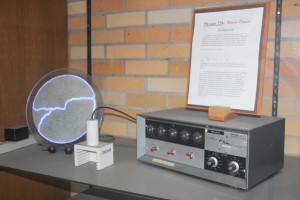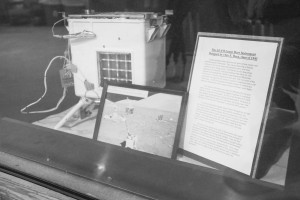Dean decides new science facilities will not house two million dollars’ worth of NASA equipment

In the late 1940s, a young man named Otto Berg graduated from Concordia College and was later employed at NASA. In 1965, he designed an instrument for the Apollo 17 mission to study the effects of dust particles striking the moon.
Along with this instrument, he built a high-speed dust particle accelerator to test the instrument before it entered space. In 1975, after that accelerator had served its purpose with NASA, he made arrangements for it to reside at Concordia.
The original purpose of the accelerator was to shoot particles at the instrument that Berg built for Apollo 17, according to Dr. Heidi Manning, professor of physics.
“Before [the instrument] could be flown, they needed to calibrate it and test it,” Manning said. “So [Berg] made this accelerator to send the high-speed particles…to see how the detector worked, so that when it got up to the moon they would know that it was responding properly.”
Now, 40 years later, the college will say its final goodbye to the high-speed dust particle accelerator as construction begins on the new Jones & Ivers science buildings.
Eric Eliason, dean of the college, said his decision to remove the dust accelerator from the renovated science facilities was not made quickly or easily.
“As the architects worked with faculty and staff to arrive at decisions about space in the buildings, we knew that the size, weight, and sensitivity of the dust accelerator would pose challenges and various possible accommodations were considered,” Eliason said in an email statement. “In the end, there were only a small number of possibilities that were compatible with the needs of the dust accelerator, and each of these had significant consequences for the design of the facilities project.”
Eliason said he listened to the variety of perspectives which faculty articulated in regard to the dust accelerator, then decided to follow the advice of the faculty and architects. According to Eliason, they believed that it was a better long-term plan not to incur the negative design consequences that would have been required to include a workable space for the dust accelerator.
“This decision disappointed some, but I continue to believe it is a good decision for the college,” Eliason said in his statement.
Since the decision was made, the college has made significant efforts to identify another school that might have a place for this equipment, but it has not succeeded so far, according to Eliason.
The college is working with NASA to determine ownership of the accelerator, according to Manning. It will be scrapped in the near future if a home is not found.

“I think it’s very unfortunate that the institution was entrusted with a piece of equipment from NASA — a valuable piece of equipment — and I can see some people saying it’s time to move on and buy new equipment, but to put a two million dollar piece of scientific equipment into the recycling is difficult,” Manning said.
There are currently two other functioning high-speed dust particle accelerators in the world, according to Manning.
University of Colorado Boulder has the most recent one, which was built two years ago, according to Manning. The other is at the Max Planck Institute for Nuclear Physics in Heidelberg, Germany. Before UCB built their accelerator, Concordia had the only one in the United States, Manning said.
“It’s [the accelerator] a rare thing [in the] tight-knit scientific community,” Manning said. “It’s very collaborative. [Researchers in this community] work together to try and understand what high-speed dust particles do.”
When UBC was informed of Concordia’s contemplation to remove the accelerator in December of 2014, Mihaly Horanyi, director of UBC’s department of physics, wrote a letter of support for Manning’s effort to keep the accelerator. In the letter, Horanyi stated that the institute in Germany is also struggling to keep their accelerator.
“Other than your facilities and ours, these capabilities are not available in the US, and if Heidelberg is closing, anywhere else in the world,” Horanyi said in the letter. “In addition to the facilities themselves, the accumulated technical knowledge of the personnel involved cannot be replaced.”
Manning has led student research and conducted her own research with the particle accelerator. She explained that the accelerator is a 38-feet long, five-ton piece of equipment that takes micron-sized particles, which are about one-fiftieth the diameter of human hair, and shoots them at targets at the high speed of 1 to 20 km per second.
Since Concordia received the accelerator in 1975, different graduate students and researchers from around the country have conducted instrument and material testing with it.
Manning said scientists from Los Alamos National Lab in New Mexico, where the first nuclear bomb was tested, came to Concordia and used the accelerator to test tiny detectors that they were using in explosions.
One graduate student from California Institute of Technology came to Concordia in 2001 to test an instrument design that he built for space. Now his similar instrument design that he tested at Concordia, will be included on one of the next launching spacecrafts, according to Manning.
Along with researchers throughout the country, Concordia student researchers and students in upper level labs have also worked with the accelerator.
Thomas Flynn, a Concordia alumnus who graduated in 2009 with a Bachelor of Arts in physics, conducted work on the accelerator with a classmate, Manning and scientists from Sandia National Laboratories from 2007 to 2008.
“Our daily tasks ranged from preparing samples, preparing the accelerator for experimental runs, and inspecting samples with a scanning electron microscope for potential impacts,” Flynn said in an email interview.

Flynn said he learned many lessons from his work with the accelerator, including the importance of collaborating with others, the ability to gather unbiased data and the drive to improve the processes he encountered daily.
“As I progressed through graduate school and into my first position as a field engineer, I continued to lean on the lessons learned while working with the accelerator,” Flynn said.
Carl Bailey, the college’s first academic dean, was instrumental in acquiring the accelerator, which he believed would enhance research opportunities for physics students. Students, faculty and outside scholars used the machine most in the 1970s and early 1980s when it was new. After Bailey and other faculty members who used it during this time retired, the accelerator was not used again until the late 1990s, according to Manning.
“It kind of went into this hibernation mode and when I came in 1997, I was looking around, wondering what I could do for my research,” Manning said. “I picked up on . . . this thing that’s not being used right now, and I got it back up and going.”
Manning designed a lab activity that included the accelerator and worked with students such as Flynn and outside collaborators to con-duct research. The last major project that included an outside collaborator was completed in 2007, according to Manning.
“There was a period of time [after 2007] where I was the division chair and with my administrative responsibilities I didn’t get down to the lab that often, so I didn’t have any big projects there,” Manning said. “But, I would say that was a shorter period of time than in the 80s and 90s and it was still functional.”
Other professors and students worked with the accelerator but Manning used it the most since the 1990s compared to other faculty. Neither
staff nor students have used it frequently since the late 2000s. However, the accelerator still runs. While the age of the accelerator concerned
some faculty, it did not concern Flynn. Flynn said any flaws encountered while working with the aging accelerator were approached as catalysts for him to pursue potential updates of the system and also made him appreciate the technology he was able to use in different labs.
“I didn’t see any downside to working with an aging piece of equipment,” Flynn said. “I also thought it was pretty neat to be working with
equipment used during the Apollo era of our nation’s space program.”
According to Flynn, the invaluable experiences he had while working with the accelerator continue to influence how he conducts himself as
a professional and a person today. “The accelerator was my first opportunity
to conduct research and it truly inspired me to continue to pursue science not only as my education but as a passion in my life,” Flynn said.
“Although the equipment is outdated, I believe it would provide significant experience to students.”

